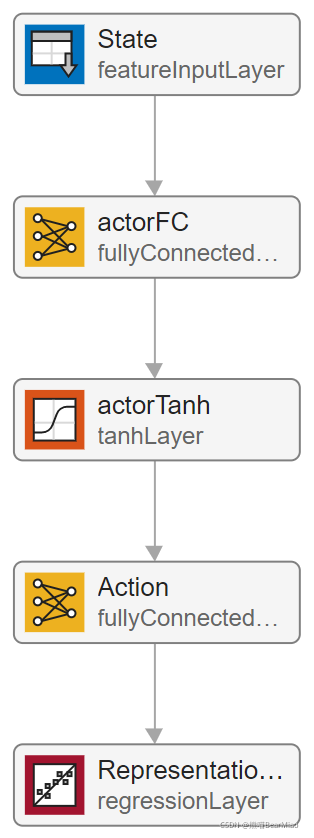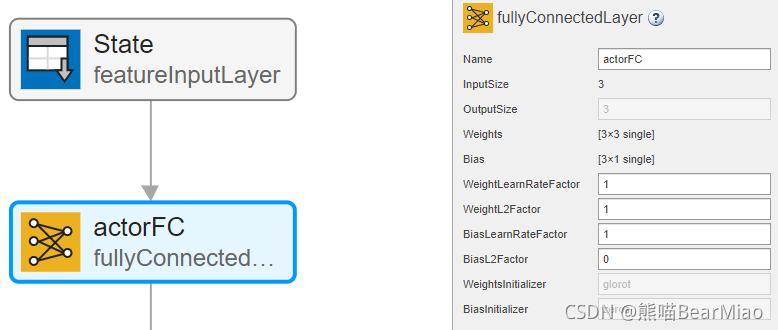原算例见
actor
从agent中提取actor信息
actor = getActor(agent)得到如下内容:
>> actor = getActor(agent)
actor =?
? rlDeterministicActorRepresentation with properties:? ? ? ? ?ActionInfo: [1×1 rl.util.rlNumericSpec]
? ? ObservationInfo: [1×1 rl.util.rlNumericSpec]
? ? ? ? ? ? Options: [1×1 rl.option.rlRepresentationOptions]
?从actor中提取学习到的参数
params = getLearnableParameters(actor)
得到如下结果
?>> params = getLearnableParameters(actor)
params =
? 1×4 cell array
? ? {3×3 single} ? ?{3×1 single} ? ?{1×3 single} ? ?{[1.8352]}
?那么上述数据究竟是何含义?
从actor中提取actor网络
actorNet=getModel(actor)得到如下内容:
>> actorNet=getModel(actor)
actorNet =?
? DAGNetwork with properties:? ? ? ? ?Layers: [5×1 nnet.cnn.layer.Layer]
? ? Connections: [4×2 table]
? ? ?InputNames: {'State'}
? ? OutputNames: {'RepresentationLoss'}
在criticNet中终于看到了Layers信息和Connections信息,如下所示:
?>> actorNet.Layers
ans =?
? 5×1 Layer array with layers:? ? ?1 ? 'State' ? ? ? ? ? ? ? ?Feature Input ? ? ? 3 features
? ? ?2 ? 'actorFC' ? ? ? ? ? ? ?Fully Connected ? ? 3 fully connected layer
? ? ?3 ? 'actorTanh' ? ? ? ? ? ?Tanh ? ? ? ? ? ? ? ?Hyperbolic tangent
? ? ?4 ? 'Action' ? ? ? ? ? ? ? Fully Connected ? ? 1 fully connected layer
? ? ?5 ? 'RepresentationLoss' ? Regression Output ? mean-squared-error
>> actorNet.Connections
ans =
? 4×2 table
? ? ? ?Source ? ? ? ? ? ? Destination ? ? ?
? ? _____________ ? ?______________________
? ? {'State' ? ?} ? ?{'actorFC' ? ? ? ? ? }
? ? {'actorFC' ?} ? ?{'actorTanh' ? ? ? ? }
? ? {'actorTanh'} ? ?{'Action' ? ? ? ? ? ?}
? ? {'Action' ? } ? ?{'RepresentationLoss'}
上述信息不直观,在?deepNetworkDesigner中打开如下所示:
deepNetworkDesigner(actorNet)
?在这张图上终于看到了全景。?
?根据右侧的Propeties可以清楚看到params与网络的对应关系,如下所示:

?可以得到:
params{1}为actorFC的W;
params{2}为actorFC的b;
params{3}为Action的W;
params{4}为Action的b;
critic
从agent中提取critic信息
critic = getCritic(agent)得到如下内容:
>> critic = getCritic(agent)
critic =?
? rlQValueRepresentation with properties:? ? ? ? ?ActionInfo: [1×1 rl.util.rlNumericSpec]
? ? ObservationInfo: [1×1 rl.util.rlNumericSpec]
? ? ? ? ? ? Options: [1×1 rl.option.rlRepresentationOptions]
?从critic中提取学习到的参数
params = getLearnableParameters(critic)
得到如下结果
?>> params = getLearnableParameters(critic)
params =
? 1×8 cell array
? Columns 1 through 2
? ? {50×3 single} ? ?{50×1 single}
? Columns 3 through 4
? ? {25×50 single} ? ?{25×1 single}
? Columns 5 through 6
? ? {25×1 single} ? ?{25×1 single}
? Columns 7 through 8
? ? {1×25 single} ? ?{[0.0879]}
?那么上述数据究竟是何含义?
从critic中提取critic网络
criticNet = getModel(critic)得到如下内容:
>> criticNet = getModel(critic)
criticNet =?
? DAGNetwork with properties:? ? ? ? ?Layers: [10×1 nnet.cnn.layer.Layer]
? ? Connections: [9×2 table]
? ? ?InputNames: {'State' ?'Action'}
? ? OutputNames: {'RepresentationLoss'}
在criticNet中终于看到了Layers信息和Connections信息,如下所示:
?>> criticNet.Layers
ans =?
? 10×1 Layer array with layers:? ? ?1 ? 'State' ? ? ? ? ? ? ? ?Feature Input ? ? ? 3 features
? ? ?2 ? 'CriticStateFC1' ? ? ? Fully Connected ? ? 50 fully connected layer
? ? ?3 ? 'CriticRelu1' ? ? ? ? ?ReLU ? ? ? ? ? ? ? ?ReLU
? ? ?4 ? 'CriticStateFC2' ? ? ? Fully Connected ? ? 25 fully connected layer
? ? ?5 ? 'Action' ? ? ? ? ? ? ? Feature Input ? ? ? 1 features
? ? ?6 ? 'CriticActionFC1' ? ? ?Fully Connected ? ? 25 fully connected layer
? ? ?7 ? 'add' ? ? ? ? ? ? ? ? ?Addition ? ? ? ? ? ?Element-wise addition of 2 inputs
? ? ?8 ? 'CriticCommonRelu' ? ? ReLU ? ? ? ? ? ? ? ?ReLU
? ? ?9 ? 'CriticOutput' ? ? ? ? Fully Connected ? ? 1 fully connected layer
? ? 10 ? 'RepresentationLoss' ? Regression Output ? mean-squared-error?
?>> criticNet.Connections
ans =
? 9×2 table
? ? ? ? ? ?Source ? ? ? ? ? ? ? ?Destination ? ? ?
? ? ____________________ ? ?______________________
? ? {'State' ? ? ? ? ? } ? ?{'CriticStateFC1' ? ?}
? ? {'CriticStateFC1' ?} ? ?{'CriticRelu1' ? ? ? }
? ? {'CriticRelu1' ? ? } ? ?{'CriticStateFC2' ? ?}
? ? {'CriticStateFC2' ?} ? ?{'add/in1' ? ? ? ? ? }
? ? {'Action' ? ? ? ? ?} ? ?{'CriticActionFC1' ? }
? ? {'CriticActionFC1' } ? ?{'add/in2' ? ? ? ? ? }
? ? {'add' ? ? ? ? ? ? } ? ?{'CriticCommonRelu' ?}
? ? {'CriticCommonRelu'} ? ?{'CriticOutput' ? ? ?}
? ? {'CriticOutput' ? ?} ? ?{'RepresentationLoss'}
上述信息不直观,在?deepNetworkDesigner中打开如下所示:
deepNetworkDesigner(criticNet)
在这张图上终于看到了全景。?
?根据右侧的Propeties可以清楚看到params与网络的对应关系,如下所示:

?可以得到:
params{1}为CriticStateFC1的W;
params{2}为CriticStateFC1的b;
params{3}为CriticStateFC2的W;
params{4}为CriticStateFC2的b;
params{5}为CriticActionFC1的W;
params{6}为CriticActionFC1的b;
params{7}为CriticOutput的W;
params{8}为CriticOutput的b;